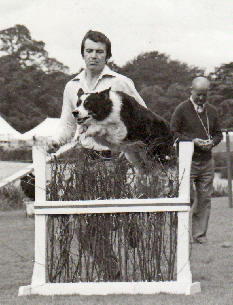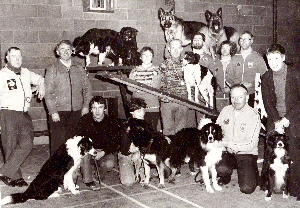John Leslie meets
an agility pioneer...
 As
the sport of dog agility celebrates its thirtieth year, and the 2008 Kennel Club International
Agility Festival approaches, Fred Welham remembers the pioneering days of the very first
agility competition. John Leslie of The Kennel Club travelled to Goole, Lincolnshire, to
interview the man who built the first set of agility equipment. Reprinted with the kind
permission of the Kennel Gazette. As
the sport of dog agility celebrates its thirtieth year, and the 2008 Kennel Club International
Agility Festival approaches, Fred Welham remembers the pioneering days of the very first
agility competition. John Leslie of The Kennel Club travelled to Goole, Lincolnshire, to
interview the man who built the first set of agility equipment. Reprinted with the kind
permission of the Kennel Gazette.
It was just thirty
years ago, at Crufts 1978, that the crowds lining the balconies of the Grand Hall at Olympia
thrilled to the very first competition in what was to become the dog world's fastest-growing
sport – agility.
Not that the small
group of participants who brought agility to Crufts had any idea at the time how quickly the
new sport would develop. One of those pioneers was Fred Welham, a leading light of the
Yorkshire Working Trials Society, who was not only one of the first agility judges, but also
claims to have built the very first set of agility equipment.
That first Crufts
Agility Test was really just meant as a demonstration,' says Fred Welham. 'It was thought up
by John Varley, a member of the Crufts committee, as an entertainment between the ‘big ring'
main events like the Obedience Championships, Group judging and Best in Show.'
Varley had also
devised the Crufts Personality Parade, which starred guide dogs, search & rescue dogs,
Obedience and Working Trials Champions and others - not forgetting Doctor Who's robot dog K9 -
parading under the spotlights to suitable poetry.
The agility
demonstration was put together in a short space of time. Varley had explained his idea to Peter
Meanwell from Lincolnshire Alsatian Association and All Breeds Training Society (as it was
called then) asking if he would help him to design a 'pony club' style event for dogs at
Crufts.
'We first heard
about it at the Kennel Club Working Trials Championship in October 1977,' says Welham.
 There,
Meanwell involved members of his own Lincoln club together with fellow Working Trials Council
member Trevor Jones and others, including Welham, from Yorkshire Working Trials Training
Society. There,
Meanwell involved members of his own Lincoln club together with fellow Working Trials Council
member Trevor Jones and others, including Welham, from Yorkshire Working Trials Training
Society.
'Crufts was in
February – and we really just started training before Christmas,' says Welham. 'Trevor Jones
was working for a big company, but he made arrangements with a supermarket client to ‘cover'
the time off he needed to spend on getting agility off the ground. We found a disused
warehouse on Yeadon airport (now Leeds Bradford Airport) and started training in there.'
Welham recalls that
he built the agility equipment that the Lincoln and Yorkshire teams first trained on:
'I built the
original set and designed a training course in that warehouse in Leeds. Lincoln came up and
trained together with us on the course I had built. It was all very friendly.
Then they
went back and built another set based on what I had done.'
Not all the
equipment would be familiar to present-day agility competitors.
'We didn't buy
anything to make it,' says Welham. 'After all, it was just going to be a one-off
demonstration. A lot of it was made from old wooden pallets. Trevor Jones borrowed four
builders' planks (which never did get returned) and asked me to do something with them, so I
made a catwalk and a see-saw; I designed the catwalk and the A-frame in my head. The tunnel
was made from some tunnel air vent piping used in a nearby pit.'
'The tyre was made
from a 16 inch car tyre – it had to come from a VW Beetle, because almost all the other
post-war cars had smaller wheels. For the frame holding the tyre, I used an old iron
double bed frame provided by a friend in the Leeds council cleansing department – we just
ground off the cast iron decorations at the corners,' Welham says. 'And the window jump was
just a standard door with the top panel knocked out.'
 The window jump was
abandoned when the Kennel Club drew up the first agility regulations in 1980, as it was felt
the 5 foot drop to the ground was too great. It was not the only feature of early agility that
has been changed or abandoned in the intervening years. Figure of eight courses with a
compulsory change of direction (clockwise to anti-clockwise or vice-versa) are no longer
mandatory, and we no longer see ring stewards at each corner of the course and judging the
weaves and the contact points. The weave poles themselves are no longer adorned with little
flags. The window jump was
abandoned when the Kennel Club drew up the first agility regulations in 1980, as it was felt
the 5 foot drop to the ground was too great. It was not the only feature of early agility that
has been changed or abandoned in the intervening years. Figure of eight courses with a
compulsory change of direction (clockwise to anti-clockwise or vice-versa) are no longer
mandatory, and we no longer see ring stewards at each corner of the course and judging the
weaves and the contact points. The weave poles themselves are no longer adorned with little
flags.
The ‘scale' (adapted
from Working Trials), now called an A-frame or A -ramp, rarely features as an 'Over and Under' –
that is, a tunnel placed underneath the A-frame used to reverse the dog's direction. Refusals
incur only five points, not ten as in the original 1980 regulations. And the custom of allowing
competitors to practise on the course in the morning before competing in the afternoon has
disappeared.
 Some
things don't change, though. The Dog World report on that very first Crufts event
observes that the Lincolnshire team included two German Shepherds and two collies, while the
winning Yorkshire team was all collies Some
things don't change, though. The Dog World report on that very first Crufts event
observes that the Lincolnshire team included two German Shepherds and two collies, while the
winning Yorkshire team was all collies
'The team of
Working Collies had a clear advantage, they were so much faster', comments the reporter. Fred
Welham still remembers the original Crufts with excitement. 'There was a terrific atmosphere
with people crowding the balconies to watch, and we had free food and booze thanks to
Pedigree,' he recalls.
Despite the
inevitable adjustments, agility quickly gained popularity. During 1978 three qualifiers for the
Crufts Agility were set up, at the British Dog Fair at Hickstead and at Sheffield and
Wakefield. Teams from Yorkshire, Rugby and Pontefract qualified for Crufts 1979, where this
time Fred Welham was judging (and Yorkshire won again).
In December 1979 the
first Pedigree Chum Agility Stakes were held at the Olympia Horse Show, also following a series
of qualifiers. It was the shape of things to come. The Crufts and Olympia finals and their
qualifiers remained an annual fixture and still represent the peak of ambition for all serious
UK competitors. By 1981 Dog Training Weekly was able to list 12 agility tests including
a two-day North v. South match. Twenty years on, in 1998, there were 200 licensed UK agility
tests, and in 2007 there were 342.
Welham didn't
entirely approve of the way agility was changing: 'I think when Pedigree came in, they
changed things by introducing money; for a few years there were quite large cash prizes being
offered and it changed the spirit of the competition,' he says. As he wrote in his judge's
report on the agility tests he judged at the first British Dog Fair at Hickstead:
'Agility tests are only recognised by the Kennel Club as a ‘fun thing' and we must not lose
sight of this'.
Fred Welham hasn't
severed all his links to agility, though. He was invited to judge a special 25th
anniversary commemorative agility class at Crufts in 2003 and was a guest of honour at a 30th
anniversary agility show held by Lincolnshire German Shepherd Dog and All Breeds Training
Society last year. The show's eight rings and 4000 entries epitomised for Welham the changes
that have taken place in the sport of agility in the past thirty year.
Reprinted with kind permission of
Kennel Gazette (July 2008)
 About
the author... About
the author...
John Leslie
is a former financial journalist turned computer and
database consultant. He got involved with Agilitynet in self-defence as he is married to
Agilitynet's own Ellen
Rocco. If you can't beat them, join them.
He is currently employed in the WTOA department of The
Kennel Club
He runs two large Standard Poodles called Bill and Beau
and trains at Trent Park where he is also an instructor.
When not on the agility course, John sings in the
Islington Choral Society and enjoys concerts when they don't compete with shows. He is
currently Chair of the group.
|